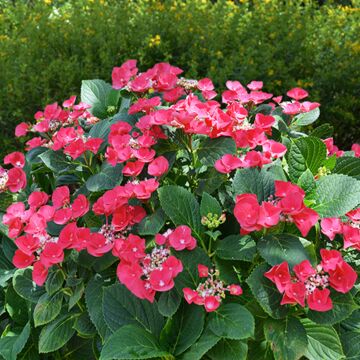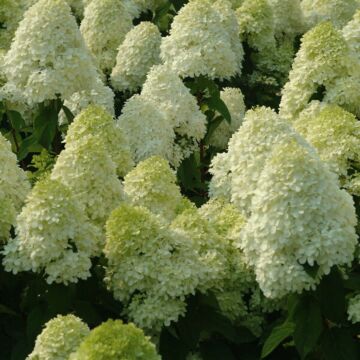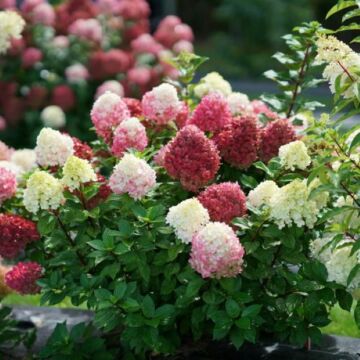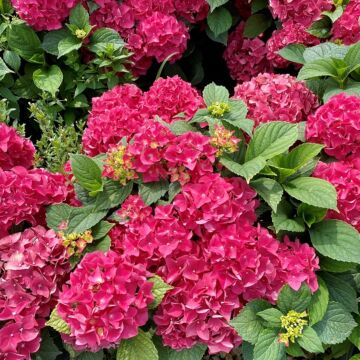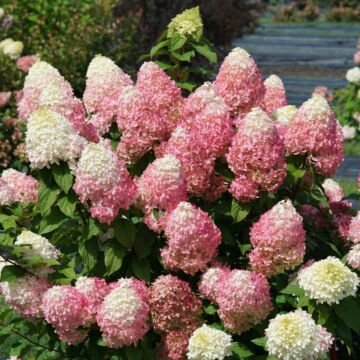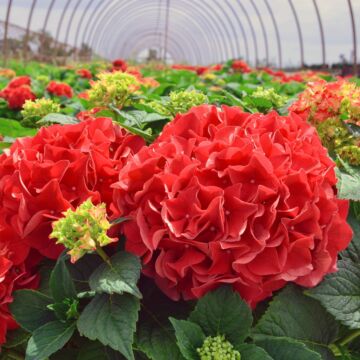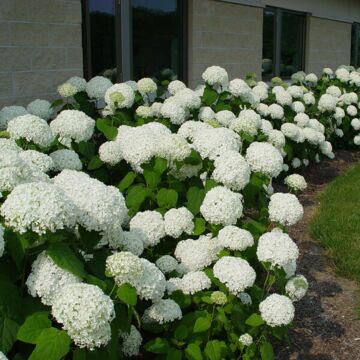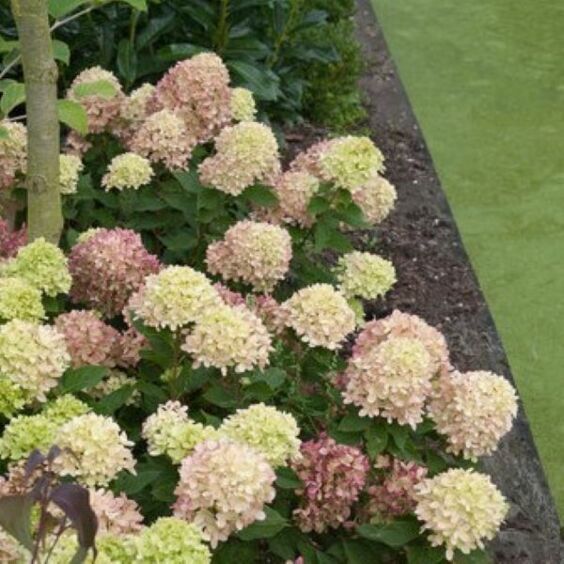
Growing zones
See Zone Map >Status: In stock
- Sun, Part Sun/Shade, Shade
Mature Plant Size (H x W): 3-5' x 3-5'
Bloom Season: Summer, Fall
- Attracts Bees
- Salt Tolerant
- Low Maintenance
- Long Blooming
- Cut Flower
- Attracts Pollinators
Planting & Care for Little Lime® Hydrangea
Preparation
- These shrubs need damp soil high in organic matter.
- Improve poor soil areas by digging in plenty of well-decayed manure or compost a few month ahead of planting
- Hydrangeas can be planted March-November.
- Pick a spot that has dappled sunlight or morning sun and afternoon shade.
- Make sure they are sheltered from frosty winds, which will damage blossoms.
Opening Plant Material
- Bare Root: Cut open the bundle (top and roots are tied) and separate all the plants. Soak roots in buckets of water until planted. Each plant type will be labeled separately for identification. Keep the roots from the full sun since they should never dry out. Keep roots covered. All bare-root plants must be trimmed when planted.Completely saturate all container plants by putting in a larger container of water until stops bubbling, then remove the plant from the container.
- Containers: Completely saturate all container plants by putting them in a larger water container until bubbling stops. Remove the plant, then dig a hole no deeper than the depth of the container, ensuring it’s wider on the sides by an additional 6” or more.
Planting Bare Root
- Hydrangeas can be planted around March-November.
- Dig a hole at least 6" wider and the same depth as the root mass. The plant's crown or graft should be slightly higher than the ground level where it was grown at the nursery.
- Trim off the broken roots and branches.
- Place fertilizer packets in the hole (if purchased). Do not place other fertilizers in the planting hole. *Use Our Recommended Fertilizer.
- Spread the roots and fill halfway with soil, then water until the soil settles completely, saturating the soil and planting pit.
- Re-adjust the plant and fill the hole with the rest of the soil.
- Backfill the balance of the soil and water well.
Planting Containers
- Slide the plant from the pot by tapping on the bottom of the pot.
- With a shovel or knife, trim the bottom 2" off the root ball for plants in plastic containers.
- Rotate the plant to the proper position. Never lift or move plants by the tops.
Place the root ball in the hole. - Adjust the plant height so the root crown is slightly higher than the ground.
- Notice where the base of the trunk flares out from the tree. This is called the root flare. This root flare should show when the tree is planted. Add soil under the ball so the root flare is exposed if necessary.
- Place fertilizer packets into the bottom of the hole (if purchased). *Use Our Recommended Fertilizer.
- Backfill the hole with soil, ensuring the top of the root ball is visible and slightly higher than the soil around it.
- Firm the soil around the plant. Water well to settle soil around the root ball.
Water frequently when newly planted. - Mulch plants with well-rotted organic matter after planting.
Pruning - After Planting
- Bare Root: Prune ALL bare root plants to reduce transplant shock and ensure successful planting. Pruning should occur as soon as possible, before or after planting, and with sharp pruning shears.
- Containers: Although it’s not essential after planting, light pruning can improve a Little Limelight Hydrangea’s shape. Doing so removes any broken branches from shipping or thins out a heavily branched plant to help in the transplanting process and the appearance of your new planting.
Pruning - Through-out the Season
- Hydrangeas should be pruned after the spring bloom.
- With hydrangeas there are several different types and with that comes different pruning tips.
- Hydrangea macrophylla - Cut off spent flowers in spring and remove crowding shoots.
- Hydrangea paniculata - Prune stems to within two buds of the base in late March.
- Hydrangea petiolaris - Cut out unwanted shoots when flowers fade.
- Hydrangea villosa - Remove a third of older stems in spring.
Watering - After Planting
- Plants typically take approximately 6 weeks to establish new roots in your soil. During this period, water plants as often as every 2-4 days at the start and at least a minimum of once per week.
- Beyond the 6 week establishment period, water once per week, unless rains occur.
- Stick your finger into the soil around 3” to check soil moisture.
Watering - Through-out the Season
- After the first season, plants should only be watered during extended periods without rain.
- How do you know if your plants need water? The easiest way to tell is to touch the soil around the roots. If it is moist, there is no need to water. If it is dry, give it a good soaking with the hose end (no nozzle) watering the soil only, not the leaves.
- Stick your finger into the soil around 3” to check soil moisture.
Frequently Asked Questions
Can Little Lime® Hydrangea tolerate winter weather?
Yes, Little Lime® Hydrangeas are exceptionally hardy, drought-tolerant, and well-suited for colder climates.
They can withstand winter temperatures as low as those found in USDA zone 3. This robust quality makes them an excellent choice for gardeners in many regions, even those with harsh winter conditions.
To ensure optimal health and blooming through the colder months, provide some winter protection to your plants. You can do this by mulching around the base of the plant to help insulate the roots and maintain soil moisture.
Are there common pests to watch out for when caring for dwarf Limelight Hydrangea?
Aphids and spider mites are some of the most frequent destroyers of panicle hydrangeas. Aphids can cause leaf curling and stunted growth by sucking sap from the leaves, while spider mites lead to fine webbing and yellowed leaves.
Regular monitoring and appropriate treatment, such as insecticidal soap or neem oil, can help manage these pests effectively and keep your hydrangeas healthy.
How can I enhance the blooming of my dwarf Limelight Hydrangea?
Dwarf Limelight Hydrangeas produce blooms on the current season's growth, known as "new wood." To maximize Limelight Hydrangeas’ bloom potential, prune these shrubs in late winter or by spring before new growth emerges. This timing helps prevent accidentally cutting off buds that will produce this season's flowers.
Additionally, removing spent flowers, a practice called deadheading, can promote a second flush of blooms later in the season. For optimal flowering, a limelight panicle hydrangea should receive at least six hours of sunlight daily.
Don’t forget to provide adequate sun exposure as it energizes the plants to produce more blooms and enhances overall health.
What are some landscaping ideas using Little Lime® Hydrangea?
Little Limelight Hydrangeas are versatile and attractive shrubs that offer a wide range of landscaping possibilities. Their compact size makes them ideal for foundation plantings, where they can enhance the architectural features of a home without overwhelming the space.
They also serve beautifully as border plants, creating a structured look along walkways or garden perimeters with the vibrant colors of hydrangea blooms. When planted in a series, Little Lime® Hydrangeas can form a lush, low hedge that provides color and texture throughout the seasons.
How long does a Little Limelight Hydrangea live?
Little Lime® Hydrangeas are known for their longevity and resilience. Properly tended, these shrubs can live for over 40 years, providing consistent beauty with their lush foliage and striking blooms.
Maintaining optimal growing conditions is important to ensure their long life. This includes planting them in well-drained soil rich in organic matter to support their growth and blooming.
Upgrade Your Landscaping’s Impact With McKay Nursery
At McKay Nursery, we leverage over a century of expertise in horticulture to bring you premium plants like the delightful Little Lime® Hydrangea. Located in the heart of Waterloo, Wisconsin, our nursery is dedicated to raising hardy, quality plants.
Opt for McKay Nursery for your garden essentials and enjoy plants of the highest caliber, all assured by our comprehensive warranty. Our packaging ensures your plants arrive in great condition, ready to beautify your landscape.
Order your Little Limelight Hydrangea today! For personalized advice or additional support, don’t hesitate to contact us at [email protected] or 920-478-2121.
Planting & Handling Help
Download our Planting and Handling Guide below to plan for a successful arrival and install of your plants. Be sure to water all plants as soon as they arrive and every day until you’re ready to plant. Keep any bare root bundles in a shady, cool spot with the roots covered at all times.


Learn More
Watch our videos on handling bare root plants, how your order is prepared for shipment and more.


Plant Sizing
What is the difference between Containers, Grow Bags, Bare Root, and Balled & Burlap (B&B)?
Shipping Times


Our FedEx and local shipping times depend on two factors, one is by the region and the second is the type of product being shipped. For example, small fruits are only shipped in spring, but majority of our perennials are shipped from spring until fall. Keep in mind the dates below act as a general guide. Due to unpredictable weather, staffing, inventory and industry demands these timelines can change. Therefore, we cannot guarantee any of these times.
Shipping Dates by Region*
Northern Cold Region: April 22nd - November 7th
Northern Region: April 15th - November 7th
Middle Region: April 1st - November 7th
Southern Region: March 15th - November 7th
Local Delivery (small radius from Waterloo, WI): April 22nd - November 7th
Shipping Dates by Season*
Spring Shipping: Region Start Date (above) - May
Fall Shipping: September - November
Due to unpredictable weather, these times may vary. Some varieties are exceptions due to heat and plant health reasons. Enter your shipping zip code at the top of this page and be sure to check the shipping information on each product before you add it to your cart. If the product is too large or restricted in your state, you will not be able to checkout with that item in your cart.

